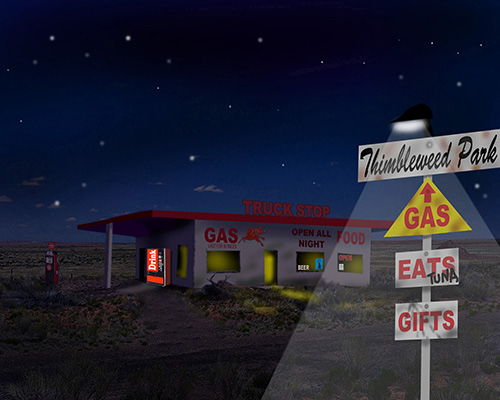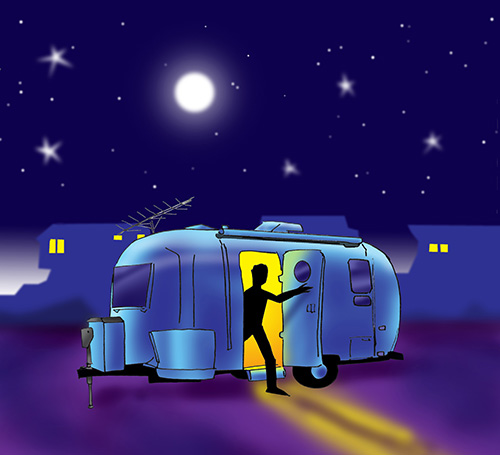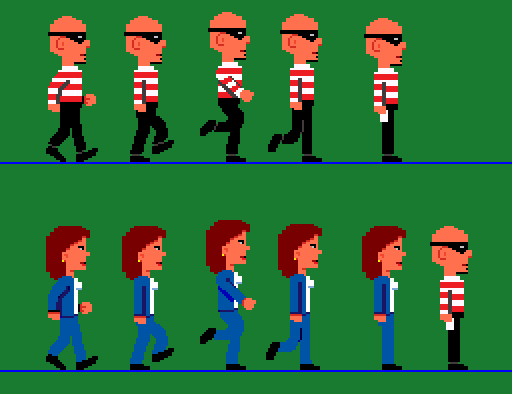Thinking About Locations and Characters
Jan 19, 2015
Although we've pretty well established our approach to the game's visual style, the first few months of design and development has a lot to do with figuring out how things will actually look and work within those constraints.

Aside from basing a location's look on a real-life counterpart, the design of its' specific puzzles and their place in the story really drives a location's visual design. In some cases we already know we need an important puzzle that does X, and we're designing a location around that, or we've decided on a location and need to come up with a good reason for it.

As we create locations and associated characters, it's important that each have their own peculiar aspect. We tend to begin with a very stereotypical/iconic concept approach to the design then try to layer on an appropriate unique twist. That way the player starts out with image they can easily identify with and understand... "I recognize that's a clown, but I don't know why he's carrying a pineapple that has a steering wheel attached to it..."

The above is an early animation test, back when we were being more faithful to the C64 palette and everyone looked orange. One of the main reasons we decided to relax our palette constraints is to be able to have more realistic and varied skin tones.
Although we'll be spending a lot of time in the near term working primarily on static images, we're also starting to think about animation as well.
We're beginning to look at 2D animation tools that run on the Mac (both Ron and I work on Macs), I'd like to find something that supports a good old-school style bitmap approach (as opposed to Flash), that might have similarity to the kind tools we used on Maniac Mansion and Monkey Island. When working on Maniac Mansion, I animated on the C64 using an in-house tool called Skedit. By the time Monkey Island came about, we were using DPaint Animator.
Any new editor should have layers, reasonable drawing tools and be able to save into an easily parseable file format. So far we're haven't found anything we like, so if anyone can recommend a good 2D animation program that runs on the Mac, please let us know.
- Gary

AFAIK, 'Spriter' also allows for bitmap animation style. It's a very cool program, running on Mac and a number of other platforms. Try contacting them, could be worth it. I know one of the makers, Mike Parent.
Aseprite is another one, and it happens to have the only thing I feel that Pixen is missing -- which is layer/selection rotation.
Ideally, a good animation tool would allow for several animations (walk left, walk front, walk back, reach high, reach low, etc) that could then be packed into a single sprite sheet with a json/xml file that controls the animation. Run-time layers are nice for things like talking or optional accessories like a hat.
Asesprite looks promising (love the retro ascetic), but it doesn't seem to be able to manage several animations in a single file, which makes combining into a single sprite sheet cumbersome. It's also a little "laggy" when editing very quickly (yes, I have a fast computer).
There is a lot to like about it, but it feels like it's 90% there and the other 10% might be very frustrating.
I'd like multiple animations to be in the same sprite sheet because they will often share frames. Also, if Gary makes a change, it would be nice if it was propagated to all the animations with having to edit multiple files.
http://blog.tube42.se/?p=1342
http://aftnn.org/post/79547282738/generate-json-index-of-images-with-awk-and
http://www.imagemagick.org/script/identify.php
That first link definitely deserves a view, and if you're convinced, check out the other two. Well, no matter what you choose, I'd like to figure this out for myself someday. As a matter of preference, I like to store everything in folders, plain text, and bitmap/png.
http://cosmigo.com/promotion/index.php
in comparison using photoshop for pixelling is kinda complicated and also has some issues depending working with 8bit depth color tables.
One of its functions is exporting animations as sprite sheets.
oh. this is quite useful. thanks for the link :)
cheers.
http://macrabbit.com/slicy/
File -> Scripts -> Export Layers (or Layer Comps) to Files
Obviously you have to define the layer comps for the latter.
e.g http://i.imgur.com/oMHvL0a.png
Good choice to go for more colors. But it may be a good idea to limit it to +/- 256 per screen to resemble that olds-cool look. Here i speak specifically of the caravan scene as seen in the kickstarter. The gradient of the sky background was too smooth (for my likes).
Furthermore, looking back at some of the kickstarter screens, sometimes you used a higher resolution noise/relief/paperlike effect. Do you intend to use it in the final design?
Don't get me wrong. Experimenting is good and it don't have to look like in the old days in every aspect. Personally i haven't decided yet if i fancy it or not. While it works quite good on environments, it looks a little odd on faces.
S.
Blender 2.73 has new grease paint tools for quick storyboard animations: http://vimeo.com/channels/greasepencil
Blender can also do 2D animation with bones (think Southpark). You basically load a transparent image into a plane, and subdivide it where you want it to bend. The bones do the rest of the work. Here's an example: https://www.youtube.com/watch?v=NFlGN7TLjHU
I don't think you'd want to build your entire game this way, but it would be great, for example, spinning the wheels on a car or what have you. Draw the car and wheels on separate layers, and then export them as separate images. Load the car on a plane, and the wheel on another plane. Duplicate the wheel to get two wheels (assuming this is a flat angle from the side). Then just rotate the wheels, and export the animation. Maybe do Chuck the Plant or a tumbleweed in this way? At this point, you can use several third-party products to assemble it into a sprite, or write a script using ImageMagick: http://www.imagemagick.org/
Ron already owns TexturePacker according to this testimonial: https://www.codeandweb.com/texturepacker
:-D
And with the built-in Freestyle rendering engine, your low-poly 3D models can get you instant pixel shading: http://i.imgur.com/3lOBv08.gif
It is a compelling technique, for sure. The animation is done, if I recall, by adding a lattice to the mesh and moving some of its points around to make the object wiggle. I'd personally add life to every scene using this technique. A cactus or plant swaying, for instance.
Maybe this will give you some ideas, if nothing else.
Here's a cool tutorial that could be used for Chuck the Plant: https://www.youtube.com/watch?v=fn0cFJW1ZdY
The result: https://www.youtube.com/watch?v=KdjR3s24t7Y
I guess if you have to learn Blender it's not worth your time, because of the steep learning curve. But if you could somehow manage, you can get practically free results in no time at all. It's amazing.
I probably wouldn't use this for walk cycles, though. I'd do those by hand or using rotoscoping.
This guy explores a great technique for homebrew rotoscoping: http://agwspeakeasy.blogspot.com/2013/05/rotoscoping-tutorial-part-2-side-walk.html
Maybe it was this guy or someone else, but they did their entire game with rotoscoping. It was very compelling. The Last Express famously used it as well as Prince of Persia and many others.
That said, if the animations are going to be like in Maniac Mansion, this is all overkill. :-)
One more suggestion:
Synfig Studio, which runs on Mac http://www.synfig.org/cms/
What about Spine? http://www.esotericsoftware.com/
We use it on our game Infamous Machine and it's really awesome!
It's a versatile tool and I backed it on kickstarter ;)
You should at least give it a try!
The design tools are raster based, though, not bitmap based, so I have no idea how easy it'd be to create your pixelated look
http://www.adobe.com/devnet/flash/articles/using-sprite-sheet-generator.html
http://pixelshuh.tumblr.com
It's a really cool 16-bit work. But he uses Photoshop...
http://www.pickleeditor.com/
They provide documentation on the format and there are sample plugins for some common engines si it should be easy to figure out how to load them and convert them in your proprietary format.
Again i want to say thanks for using good ol pixel arts. While i certainly like the scanned comic style of DOTT, the slightly cleaner yet more colorful looks of direct pixel sculpting is more to my liking. This is why i prefer MI1 over MI2. The style mixture of MM and MI1 in TP is just great! (abbr. ftw)
-Gary
Cheers,
Puma